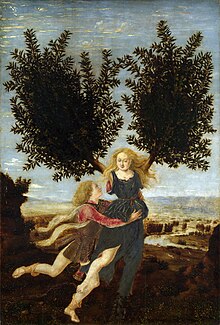
Piero del Pollaiuolo (UK: /ˌpɒlaɪˈwoʊloʊ/ POL-eye-WOH-loh,[1] US: /ˌpoʊl-/ POHL-,[2] Italian: [ˈpjɛːro del pollaˈjwɔːlo]; also spelled Pollaiolo; c. 1443 – by 1496), whose birth name was Piero Benci, was an Italian Renaissance painter from Florence. His older brother, by about ten years, was the artist Antonio del Pollaiuolo and the two frequently worked together. Their work shows both classical influences and an interest in human anatomy; according to Vasari, the brothers carried out dissections to improve their knowledge of the subject (though modern scholars tend to doubt this).[3]

Giorgio Vasari, who wrote several decades after both brothers were dead, includes a joint biography of Antonio and Piero del Pollaiuolo in his Lives of the Most Excellent Painters, Sculptors, and Architects. Vasari says that Antonio was especially highly regarded for his disegno or drawing,[4] and it may be that on shared works he did most of the underdrawing, leaving Piero and their assistants to complete the painting. Vasari began the tradition of stressing the contribution of Antonio rather than Piero to the paintings, which went largely unchallenged until the 20th century, despite suspicions by art historians such as "Crowe and Cavalcaselle" in the late 19th century,[5] and in the 20th Martin Davies, later Director of the National Gallery.[6] In the 21st century a full and partly successful challenge has been mounted, and some attributions changed.
In recent years there has been a trend among art historians to increase the credit Piero is given for the paintings, led by figures such as Aldo Galli, whose Antonio and Piero Del Pollaiuolo: Silver and Gold, Painting and Bronze (2014) assigns the actual painting of many works to Piero that had long been given to Antonio, or both brothers. At least one of the brothers was influenced by the landscape style of Early Netherlandish painting, and the revisionist school thinks that this was Piero.
- ^ "Pollaiuolo". Lexico UK English Dictionary. Oxford University Press. Archived from the original on 22 March 2020.
- ^ "Pollaiuolo". Collins English Dictionary. HarperCollins. Retrieved 29 July 2019.
- ^ Vasari; Wright, 86
- ^ Vasari; Wright, 5, 8
- ^ Galli, 42
- ^ Davies, 442–443, also 444 and 446 on the gallery's two Pollaiuolo paintings; Galli, 47.